Samurai sword stance correction guide

Alright, if you’re diving into the world of samurai swordsmanship, whether for Kenjutsu, Iaido, or simply learning to wield a sword for fitness or historical appreciation, one thing is clear: your stance is everything. As someone who’s spent years practicing with a katana, I can tell you that correcting your sword stance isn’t just about looking good or being able to throw a couple of slashes—it’s about efficiency, power, and safety. And yes, the right stance can make or break your performance in a sparring match or during practice.
Let me walk you through a Samurai sword stance correction guide that can help you avoid common mistakes and sharpen your technique. Whether you’re a seasoned practitioner or just getting started, these tips will have you standing tall, focused, and ready to deliver with precision.
The Importance of a Proper Samurai Sword Stance
When you’re holding a katana or any sword, your stance isn’t just about the position of your feet or hands. It’s a total body alignment that affects how you move, how quickly you react, and most importantly, how effectively you can deliver a strike. A well-executed stance can give you balance, agility, and even strength when cutting.
When I first started learning Kenjutsu, I remember how hard it was to get my stance just right. I was always off-balance, and my strikes didn’t have the power they should. As I worked through the corrections, I realized that even small adjustments in my feet or grip made a massive difference.
Key Stances in Samurai Swordsmanship
There are a few key stances in Kenjutsu that you’ll use for different situations, whether it’s for defense, attack, or transition:
| Stance | Purpose | Key Elements |
|---|---|---|
| Chudan no Kamae | Neutral stance, balanced for both attack and defense. | Sword at mid-chest level, hands slightly apart, feet shoulder-width apart. |
| Jodan no Kamae | High guard for attacking or counter-attacking. | Sword raised above the head, body slightly forward, ready to strike. |
| Gedan no Kamae | Low guard, used for defensive moves or deceptive attacks. | Sword pointed downwards near the waist, weight on the back leg, prepared for a quick upward strike. |
| Seigan no Kamae | Middle guard that gives you a solid defense and offense position. | Sword in front of you, angled downward, legs bent, feet rooted. |
How to Correct Your Samurai Sword Stance
1. Foot Position: Root Yourself
Your feet are the foundation of your stance, and when you’re training with a katana, your footwork is just as important as your grip. I can’t tell you how many times I had to correct my foot positioning in the early stages of training. A lot of beginners stand with their feet too wide or too narrow, but the sweet spot is somewhere between shoulder-width and hip-width apart, depending on the stance.
- Chudan no Kamae: Feet shoulder-width apart, slightly bent. This gives you balance while keeping you agile.
- Jodan no Kamae: Feet planted firmly, body slightly tilted forward. This stance is a bit more aggressive, so you want to make sure you’re grounded without being too rigid.
- Gedan no Kamae: You’ll want to shift most of your weight to your back foot. This gives you the flexibility to quickly spring into action while keeping the sword steady.
2. Aligning Your Hips and Knees
Your hips should follow the alignment of your feet. This is an area where many practitioners struggle—if your hips aren’t aligned with your feet, it throws off your entire posture. Bending your knees slightly helps you stay grounded while maintaining the flexibility to move quickly.
- When you’re in Jodan no Kamae, your hips should lean slightly forward, but don’t overdo it. If you lean too much, you risk losing your balance or overextending.
- In Gedan no Kamae, keep your knees bent, as if you’re ready to spring into an upward cut. This stance requires some flexibility in the knees and hips.
3. Proper Grip on the Katana
How you hold your katana is everything. Beginners often have a loose grip, but once I corrected this in my training, I saw an immediate difference in my ability to control my blade. You don’t need to grip the sword like you’re choking it, but you do want a firm yet relaxed grip.
- Two-Handed Grip: For most stances, your hands should be placed roughly one-third of the way down the blade. Your dominant hand (right hand for right-handed practitioners) should be closer to the hilt, while your non-dominant hand is slightly further down.
- The Iai grip is different, focusing on drawing the blade in one motion. For this, your grip needs to be strong but fluid to allow for a clean draw.
4. Balance Your Weight
It’s crucial to distribute your weight evenly in a stance. Don’t lean too far forward or back. In Seigan no Kamae, for instance, your weight should be centered, allowing you to transition easily between defense and attack.
Here’s the secret I learned early on: don’t lock your knees. This allows you to remain agile, even when you’re in a strong stance.
Common Samurai Sword Stance Mistakes to Avoid
If you’re new to the katana, it’s easy to pick up bad habits. I know I did! Let’s go over a few common mistakes I see often:
- Too Wide or Narrow Feet: This throws off your balance and makes it harder to move.
- Locked Knees: You need to stay flexible. If your knees are locked, you’ll be stiff and slow to react.
- Too Much Lean in Jodan no Kamae: If your body is too forward in Jodan no Kamae, you risk losing your balance during a strike.
- Weak Grip: A loose grip means less control over your blade. If you can’t control your sword, you can’t control your stance.
FAQ: Samurai Sword Stance Tips
Q: How long does it take to perfect a sword stance?
A: It takes time and practice—probably months to truly get comfortable with your stances, especially if you’re new to the katana. Keep practicing, and you’ll start feeling more natural in each stance.
Q: Can I practice my stance at home?
A: Absolutely! You don’t need a dojo to practice your samurai sword stance. Find a space with room to move around and practice the foot positioning and alignment. Make sure to use a bokken (wooden sword) or shinai (bamboo sword) to stay safe.
Q: What should I focus on first when correcting my stance?
A: Foot position and balance should be your starting point. Once your feet are positioned correctly, you’ll naturally find the right body alignment and grip. This is the foundation for everything else.
Conclusion
Getting your samurai sword stance right is one of the most important steps in mastering the katana. Trust me, it might feel awkward at first, but as you correct your posture, foot placement, and grip, you’ll notice a huge improvement in your swordsmanship. It’s all about building muscle memory, balance, and discipline, just like the samurai did.
So, next time you practice, take a moment to check your stance—it might just be the difference between a sloppy cut and a powerful, precise strike. Keep refining your technique, and remember: every warrior started with a solid foundation.
o3-mini
